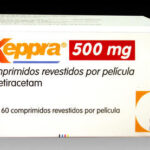What Should I Avoid While Taking Keppra (Levetiracetam)?

Keppra is a medicine that contains the active substance levetiracetam. It is available as tablets (250 mg, 500 mg, 750 mg, and 1,000 mg), as an oral solution (100 mg/ml), and as a concentrate that is made up into a solution for infusion (drip into a vein, 100 mg/ml).
Keppra can be used on its own in patients from 16 years of age with newly diagnosed epilepsy, to treat partial-onset seizures (fits) with or without secondary generalization. This is a type of epilepsy where too much electrical activity in one side of the brain causes symptoms such as sudden, jerky movements of one part of the body, distorted hearing, sense of smell or vision, numbness, or a sudden sense of fear. Secondary generalization occurs when the overactivity later reaches the whole brain.
Keppra can also be used as an add-on to other anti-epileptic medicines to treat:
- partial-onset seizures with or without generalisation in patients from one month of age;
- myoclonic seizures (short, shock-like jerks of a muscle or group of muscles) in patients from 12 years of age with juvenile myoclonic epilepsy;
- primary generalised tonic-clonic seizures (major fits, including loss of consciousness) in patients from 12 years of age with idiopathic generalised epilepsy (the type of epilepsy that is thought to have a genetic cause).
The medicine can only be obtained with a prescription.
How should this medicine be used?
Levetiracetam comes as a solution (liquid), an immediate-release tablet, an extended-release (long-acting) tablet, and as a tablet for suspension (a tablet to take with liquid) to take by mouth. The solution, immediate-release tablet, and tablet for suspension are usually taken twice a day, once in the morning and once at night, with or without food. The extended-release tablets are usually taken once daily with or without food. Try to take levetiracetam at around the same time(s) every day. Follow the directions on your prescription label carefully, and ask your doctor or pharmacist to explain any part you do not understand. Take levetiracetam exactly as directed. Do not take more or less of it or take it more often than prescribed by your doctor.
Swallow the levetiracetam immediate-release and extended-release tablets whole; do not split, chew, or crush them. Take the whole levetiracetam tablets for suspension according to directions; do not split, chew, or crush them.
To take levetiracetam tablet(s) for suspension, use dry hands to peel the foil from the blister packaging; do not try to push the tablets through the foil. Immediately take out the number of tablets that your doctor has told you to take and place the tablet(s) on your tongue with a sip of liquid. Once the tablet completely dissolves on your tongue, swallow the mixture. The tablet(s) may take about 10 seconds to dissolve.
You can also take levetiracetam tablets for suspension by dissolving them in a liquid. Place the number of the tablet(s) your doctor has told you to take into a cup and add a small amount of liquid (about 1 tablespoon [15 mL] or enough to cover the medication in a cup). Swirl the cup gently. After the tablet(s) for suspension dissolve, drink the mixture right away. If there is any medication left in the cup, add some more liquid and swirl the cup gently. Drink the mixture of water right away to be sure that you swallow all of the medication.
If you are taking the levetiracetam oral solution, do not use a household spoon to measure your dose. You might not get the right amount of medication. Ask your doctor or pharmacist to recommend a medicine dropper, spoon, cup, or syringe and to show you how to use it to measure your medicine.
Your doctor may start you on a low dose of levetiracetam and gradually increase your dose, not more often than once every 2 weeks.
Levetiracetam controls epilepsy but does not cure it. Continue to take levetiracetam even if you feel well. Do not stop taking levetiracetam without talking to your doctor, even if you experience side effects such as unusual changes in behavior or mood. If you suddenly stop taking levetiracetam, your seizures may become worse. Your doctor will probably decrease your dose gradually.
What is a drug interaction?
A drug interaction can be defined as an interaction between a drug and another substance that prevents the drug from performing as expected. This definition applies to interactions of drugs with other drugs (drug-drug interactions), as well as drugs with food (drug-food interactions) and other substances.
Whenever two or more drugs are being taken, there is a chance that there will be an interaction among the drugs. The interaction may increase or decrease the effectiveness of the drugs or the side effects of the drugs. The likelihood of drug interactions increases as the number of drugs being taken increases. Therefore, people who take several drugs are at the greatest risk for interactions. Drug interactions contribute to the cost of healthcare because of the costs of medical care that are required to treat problems caused by changes in effectiveness or side effects. Interactions also can lead to psychological suffering that can be avoided. This review discusses the issue of drug interactions and several ways to avoid them.
What Not To Take With Keppra
Studies have shown that there may be an interaction between Keppra and any of the following drugs and substances when used together:
- alcohol
- antihistamines (e.g., cetirizine, doxylamine, diphenhydramine, hydroxyzine, loratadine)
- antipsychotics (e.g., chlorpromazine, clozapine, haloperidol, olanzapine, quetiapine, risperidone)
- azelastine
- barbiturates (e.g., butalbital, pentobarbital, phenobarbital)
- benzodiazepines (e.g., alprazolam, diazepam, lorazepam)
- brimonidine
- buprenorphine
- buspirone
- cannabis
- chloral hydrate
- clonidine
- dimenhydrinate
- efavirenz
- entacapone
- general anesthetics (medications used to put people to sleep before surgery)
- kava kava
- lemborexant
- mefloquine
- methotrexate
- metoclopramide
- mirtazapine
- muscle relaxants (e.g., baclofen, cyclobenzaprine, methocarbamol, orphenadrine)
- nabilone
- narcotic pain relievers (e.g., codeine, fentanyl, hydrocodone, morphine, oxycodone)
- orlistat
- pramipexole
- rivaroxaban
- ropinirole
- rotigotine
- scopolamine
- seizure medications (e.g., carbamazepine, clobazam, phenytoin, primidone, topiramate, valproic acid, zonisamide)
- selective serotonin reuptake inhibitors (SSRIs; e.g., citalopram, fluoxetine, paroxetine, sertraline)
- sodium oxybate
- tapentadol
- tramadol
- tricyclic antidepressants (e.g., amitriptyline, clomipramine, desipramine, trimipramine)
- zolpidem
- zopiclone
If you are taking any of these medications, speak with your doctor or pharmacist. Depending on your specific circumstances, your doctor may want you to:
- stop taking one of the medications,
- change one of the medications to another,
- change how you are taking one or both of the medications, or
- leave everything as is.
An interaction between two medications does not always mean that you must stop taking one of them. Speak to your doctor about how any drug interactions are being managed or should be managed.





